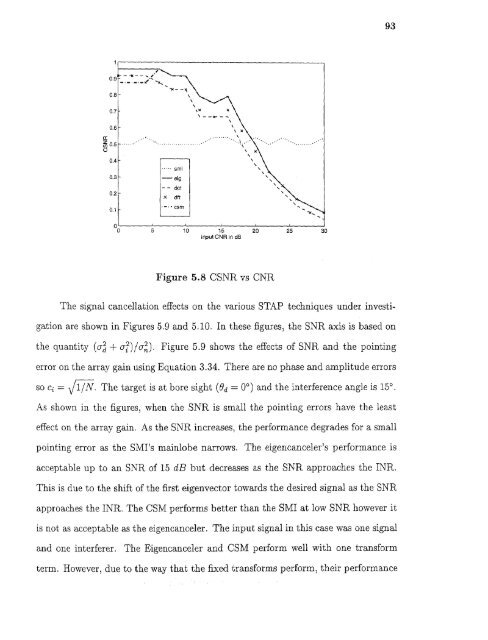Space/time/frequency methods in adaptive radar - New Jersey ...
Space/time/frequency methods in adaptive radar - New Jersey ...
Space/time/frequency methods in adaptive radar - New Jersey ...
You also want an ePaper? Increase the reach of your titles
YUMPU automatically turns print PDFs into web optimized ePapers that Google loves.
93Figure 5.8 CSNR vs CNRThe signal cancellation effects on the various STAP techniques under <strong>in</strong>vestigationare shown <strong>in</strong> Figures 5.9 and 5.10. In these figures, the SNR axis is based onFigure 5.9 shows the effects of SNR and the po<strong>in</strong>t<strong>in</strong>gerror on the array ga<strong>in</strong> us<strong>in</strong>g Equation 3.34. There are no phase and amplitude errorsso ci = \/1/N. The target is at bore sight (9d = 0°) and the <strong>in</strong>terference angle is 15°.As shown <strong>in</strong> the figures, when the SNR is small the po<strong>in</strong>t<strong>in</strong>g errors have the leasteffect on the array ga<strong>in</strong>. As the SNR <strong>in</strong>creases, the performance degrades for a smallpo<strong>in</strong>t<strong>in</strong>g error as the SMI's ma<strong>in</strong>lobe narrows. The •eigencanceler's performance isacceptable up to an SNR of 15 dB but decreases as the SNR approaches the INR.This is due to the shift of the first eigenvector towards the desired signal as the SNRapproaches the INR. The CSM performs better than the SMI at low SNR however itis not as acceptable as the eigencanceler. The <strong>in</strong>put signal <strong>in</strong> this case was one signaland one <strong>in</strong>terferer. The Eigencanceler and CSM perform well with one transformterm. However, due to the way that the fixed transforms perform, their performance
















